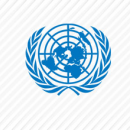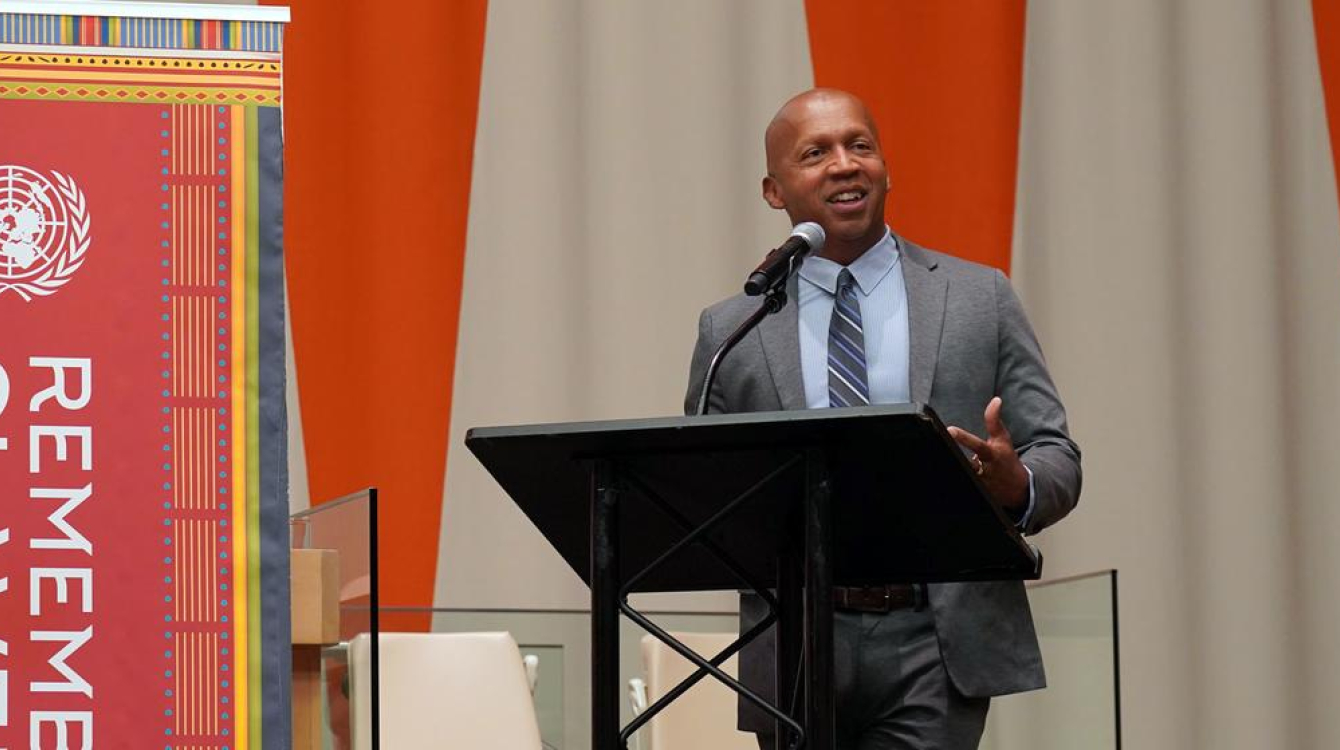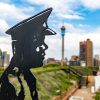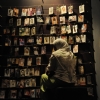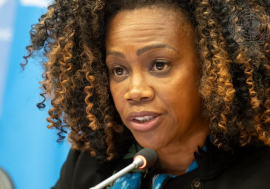The fact that museums are examining the brutal legacy of the transatlantic slave trade, and giving voice to its victims, represents “a remarkable step forward” after years of silence, renowned American lawyer and social justice activist Bryan Stevenson said in an exclusive interview with UN News:
Mr. Stevenson is the Founder and Executive Director of the Equality Justice Initiative (EJI), a non-profit that works to end mass incarceration and excessive punishment in the United States – which mainly impacts the poor and people of colour – while also challenging racial and economic injustice.
The police violence that we see today, the bigotry that we see today, the presumption that someone in a Starbucks is doing something wrong when they're just drinking their coffee - all of these things are manifestations of a narrative struggle that I believe we have to engage. And that's where culture, and art, and museums, and every institution in the world can play a role,” he said.
Links to today
The author of the best-selling memoir Just Mercy – which was also turned into a critically acclaimed film – was at the UN on Thursday 30 April to deliver the keynote address at an event organized under its annual programme to raise awareness of the transatlantic slave trade and its imprint on the modern world.
The focus this year is on fighting slavery’s legacy of racism through education. As part of that effort, an exhibition featuring 10 stories of Dutch colonial slavery is on display at UN Headquarters in New York, brought there by the Rijksmuseum in Amsterdam.
For more than 400 years, some 15 million African men, women and children were chained and trafficked to European colonies in the Americas, marking what the UN has described as a dark chapter of history.
Secretary-General António Guterres said the legacy of the transatlantic slave trade still haunts us today because “we can draw a straight line from the centuries of colonial exploitation to the social and economic inequalities of today.”
That line leads directly to the work of the EJI, which is based in Montgomery, Alabama. The southern state is considered the birthplace of the civil rights movement in the mid-1950s, triggered by Rosa Parks’ refusal to give up her bus seat to a white man.
In 2018, the EJI opened The Legacy Museum: From Enslavement to Mass Incarceration which documents how slavery is connected to sexual violence, lynching - including of children, segregation, and the high rate of incarceration of African Americans in the world’s largest prison system. The non-profit also operates the National Memorial for Peace and Justice, which honours thousands of victims of lynchings.
Mr. Stevenson is no stranger to the UN and has previously given testimony to human rights experts working to end racism, for example. He began by reflecting on his personal connection to the bitter history of slavery in the US.
The interview
Bryan Stevenson: I’m a product of the Supreme Court decision in this country, Brown v. Board of Education, so I started my education in a coloured school because black children weren't permitted to attend public schools. And lawyers really disrupted that.
They came into my community; they had the power to enforce the rule of law even though the majority of people in that community would not have voted to let kids like me into the schools. And so, I was always drawn to what lawyers can do to protect disfavoured people, marginalized people, excluded people, and I went to law school with that objective.
When I came out of law school in the 1980s, people in our jails and prisons struck me as the most vulnerable part of our population. Our prison population went from 300,000 to 2.2 million, and there were so many people facing execution, children condemned to die in prison, that my work focused on that. And we continue to do that work.
But about 12 years ago, I began to fear that we might not be able to win the decision that created opportunities for me today. I sensed a retreat from a commitment to the rule of law on behalf of disfavoured people. And that's when I looked to the humanities.
That's when I started to believe that we had to engage in narrative work to begin getting people to understand the context of so many of these issues. And I found in public history, and in culture and in museums, a really powerful opportunity to engage people. And that's what started us into developing a lot of scholarship and content about the transatlantic slave trade, slavery in America, lynching, segregation, but also creating cultural spaces that would invite people in.
I just think that's desperately needed, if we're going to get the kind of consciousness around the world that I think is needed to address the legacy of slavery, and the bigotry and violence and discrimination that we still see today.
UN News: Tell us more about your Legacy Museum. When someone goes there, what exactly would they see, or is there any particular exhibit that is particularly poignant for yourself?
Bryan Stevenson: We think of our museum as a narrative museum. So, it is a journey, beginning with the transatlantic slave trade, and the first thing you'll see is a giant wall that represents the Atlantic Ocean.
I grew up on the Atlantic Ocean in this country, but it was only when I went to Africa and stood on the other side of the ocean that I began to realize the significance of that body of water when it comes to the African diaspora. And so, we explore that, and we have animations that document all of the ships that transported 12 million Africans across that ocean.
We dig deep into where the ports were; where the spaces were where people were abducted and taken. We have animations, videos. We have one narrated by Lupita Nyong'o, the beautiful actress, who tells the story of the transatlantic slave trade.
Then we have a lot of art. We have an exhibit with 300 sculptures from a Ghanaian artist named Kwame Akoto-Bamfo that just dramatizes the humanity of people who were enslaved.
Often when we talk about slavery, we make it so distant, we make it so concrete that we forget we're talking about people, and we really want to reinforce that.
And then we take you into a room with more sculptures and images to help people understand the legacy of the harm, and the brutality of the harm. And then we just take them through history. We get into the domestic slave trade in the United States, where a million people were trafficked to the American South.
Then we get into the economic components of slavery, which had global implications that we still haven't really reckoned with. And from there we talk about Reconstruction in America. We then talk about lynching, which I see as a direct consequence of this era of slavery. We talk about the codified racial segregation and racial hierarchy that existed in this country.
And across the globe, there is this false idea that somehow black people aren't as good as white people that hasn't been addressed with the kind of determination and intent that we think is necessary.

UN News: Speaking of some of the contemporary issues – and of course some of them have existed for centuries – let’s go back to 2020, when George Floyd was killed in front of everyone’s eyes. Can you talk more about the connection between that incident and what is happening in the United States and the world today, because what happened was nothing new.
Bryan Stevenson: I think the great evil of American slavery was that we created this narrative that black people are presumptively dangerous, presumptively guilty, are not the same as white people. And that narrative gave rise to an ideology of white supremacy.
And even after our Civil War, which the North won, the narrative was actually won by the South because we held on to those ideas of racial hierarchy. And that created a century of violent terrorism directed at black people. Black people were pulled out of their homes, drowned, tortured, lynched, and our laws did not respond.
And so, we got acculturated to tolerating extreme violence against African Americans who had done nothing wrong in most instances. We codified that racial hierarchy, but that presumption of dangerousness and guilt, I believe it continued even after we passed civil rights laws in the 1960s. And so today, we're still contending with that presumption.
And the great burden in America - the reason why so many people took to the streets after George Floyd - is that you can be a doctor, or a lawyer, or a teacher; you could be kind and loving, but if you're black or brown, you will go places in this country where you have to navigate presumptions of dangerousness and guilt.
And because I'm getting older, I can tell you that when you have to constantly navigate these presumptions, it's exhausting. And there has to be a change. And so, many of us are calling for a new era of truth and justice, truth and reconciliation, truth and restoration, truth and reparation, around this narrative that has never been adequately confronted. And the police violence that we see today, the bigotry that we see today, the presumption that someone in a Starbucks is doing something wrong when they're just drinking their coffee - all of these things are manifestations of a narrative struggle that I believe we have to engage.
And that's where culture and art and museums and every institution in the world can play a role. It's when we name and acknowledge this history, when we are intentional about addressing this history, that we begin to change the dynamics. We create a new era.
I'm impressed with the Apartheid Museum in South Africa, I'm impressed with the Holocaust Memorial in Berlin, because they represent a kind of reckoning with difficult histories that we haven't really done in America; that we haven't done in many places where the legacy of slavery was felt.
UN News: You’re here at the UN, which has a programme on the transatlantic slave trade. What role do you think the UN has in addressing this legacy and moving forward with it?
Bryan Stevenson: I think the UN is the only institution in the world that has a connection to the multiple partners, the multiple players, that are implicated in the transatlantic slave trade. This was a global phenomenon. It impacted the nations of Europe. It obviously impacted the nations of Africa. It created the American States - North and South and Central American States - and implications for Asia.
It is a global phenomenon, and so having a global institution like the United Nations take this up and centre the importance of this story, I think is really, really important.
The tragedy of the transatlantic slave trade is that people were disconnected from their communities, from their tribes, from their families, from their homes. And that connection was so violent that it's hard to reconnect. If I take a DNA test, I show up in about 16 West African countries.
And so, there has to be a more global response to how we recover, how we repair the damage, how we heal from the multiple ways in which wealth and power was built in certain places, and poverty and destruction and violence was experienced in other places.
And responding to the disparity between those who profited, and those who were beaten and tormented, is really, I think, an obligation of any just society.
So, I think it's critically important that the UN be a leader in highlighting the need for reckoning, for repair, for conversation, for dialogue around the multiple ways that the legacy of slavery continues to burden us today.
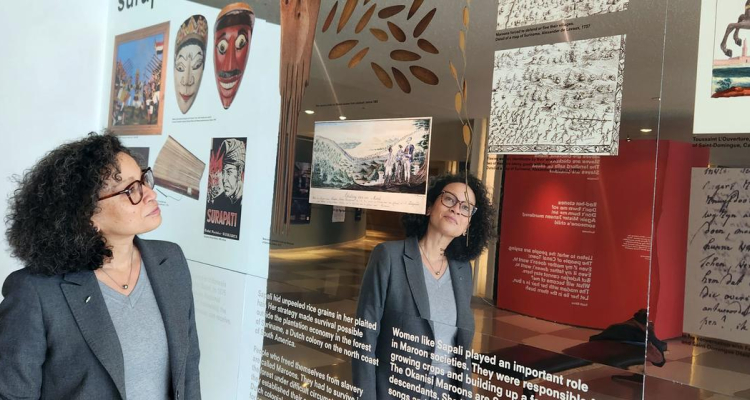
UN News: Because of the work that you do, and of course being here at the UN, are you in any way hopeful about what the future holds because these issues are still present today?
Bryan Stevenson: I'm extremely hopeful. The fact that we now have a museum in Montgomery that attracts hundreds of thousands of visitors each year; the fact that we're now engaged in narrative work at the level that we're engaged in, gives me a great deal of hope.
I never imagined even a decade ago that we would be able to kind of advance things the way they've advanced. And so, for me, justice work has always required hope.
I think hopelessness is the enemy of justice, in fact. I think injustice prevails where hopelessness persists, and I look to my enslaved fore parents for that hope because I'm the product of people who were, yes, burdened and abused and humiliated by slavery, but they still had enough hope to find love, to create new generations.
And I am one of those descendants and I carry the hope of my fore parents just like I carry an awareness of the trauma and the harm.
So, I am very hopeful that we're now having conversations in places like the UN, that we're having conversations in academic spaces across the globe; that museums that have long been silent about this history are now being intentional in addressing these histories and realities with care and thought and centering the voices of people who were enslaved is for me a remarkable step forward. And that gives me even more hope that we can get to a different place.
In our museum, the last thing we say (is) that the purpose of our museum is to create a world where the children of our children are no longer burdened by the legacy of slavery; no longer face presumptions of dangerousness and guilt. And that is an actual hope.
That is our aspiration. And I will carry that with me until we achieve that end. And I'm going to encourage everyone else to have that same hope.


